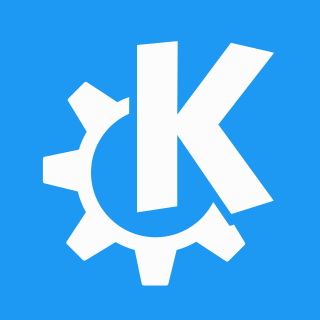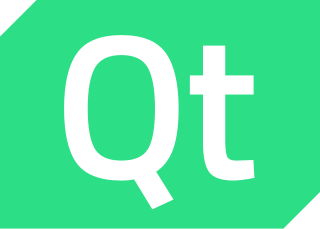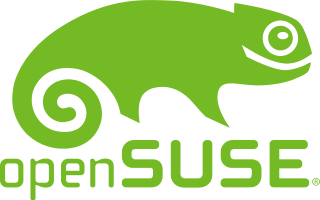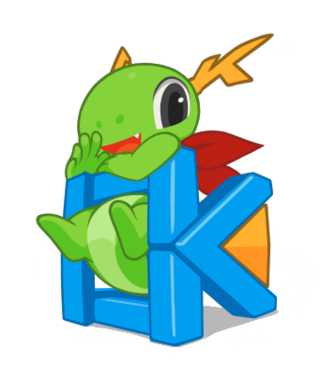
KDE is an international free software community that develops free and open-source software. As a central development hub, it provides tools and resources that allow collaborative work on this kind of software. Well-known products include the Plasma Desktop, KDE Frameworks, and a range of cross-platform applications such as Amarok, digiKam, and Krita that are designed to run on Unix and Unix-like operating systems, Microsoft Windows, and Android.

Calligra Suite is a graphic art and office suite by KDE. It is available for desktop PCs, tablet computers, and smartphones. It contains applications for word processing, spreadsheets, presentation, databases, vector graphics, and digital painting.

Calligra Words is a word processor, which is part of Calligra Suite and developed by KDE as free software.

Qt is cross-platform software for creating graphical user interfaces as well as cross-platform applications that run on various software and hardware platforms such as Linux, Windows, macOS, Android or embedded systems with little or no change in the underlying codebase while still being a native application with native capabilities and speed.

Calligra Sheets is a free software spreadsheet application that is part of Calligra Suite, an integrated graphic art and office suite developed by KDE.

Calligra Stage is a free presentation program that is part of the Calligra Suite, an integrated office suite developed by KDE.

Kexi is a visual database applications creator tool by KDE, designed to fill the gap between spreadsheets and database solutions requiring more sophisticated development. Kexi can be used for designing and implementing databases, data inserting and processing, and performing queries. It is developed within the Calligra project but is released separately.

openSUSE is a free and open source Linux distribution developed by the openSUSE project. It is offered in two main variations: Tumbleweed, an upstream rolling release distribution, and Leap, a stable release distribution which is sourced from SUSE Linux Enterprise.

Kugar is a discontinued tool for generating business quality reports for KOffice. The reports can be viewed and printed. It includes a standalone report viewer and a KParts report viewer. The latter means that any K Desktop Environment 3 application can embed the report viewing functionality and that reports can be viewed using the Konqueror browser.

KDE Plasma 4 is the fourth generation of the KDE workspace environments. It consisted of three workspaces, each targeting a certain platform: Plasma Desktop for traditional desktop PCs and notebooks, Plasma Netbook for netbooks, and Plasma Active for tablet PCs and similar devices.

Kdenlive is a free and open-source video editing software based on the MLT Framework, KDE and Qt. The project was started by Jason Wood in 2002, and is now maintained by a small team of developers.
Flake or a Vector Shape is a programming library that is used in Calligra Suite and the KOffice 2 series. Flake provides the basic concept of a "shape". To the end user a shape appears as some piece of content such as an image or a text. A shape can be in any form and contain any kind of media since the Shape is responsible for drawing itself. All components of KOffice are being overhauled to use Flake as much as possible.

Calligra Plan is a project management application that can create Gantt-style charts and is part of Calligra Suite – formerly included with KOffice.

KOffice was a free and open source office and graphics suite developed by KDE for Unix-like and Windows systems. KOffice contains a word processor (KWord), a spreadsheet (KSpread), a presentation program (KPresenter), and a number of other components that varied over the course of its development.

KWord is a deprecated word processor and a desktop publishing application, part of the KOffice suite. It has been obsoleted by Calligra Words of the Calligra Suite.

KDE Frameworks is a collection of libraries and software frameworks readily available to any Qt-based software stacks or applications on multiple operating systems. Featuring frequently needed functionality solutions like hardware integration, file format support, additional graphical control elements, plotting functions, and spell checking, the collection serves as technological foundation for KDE Plasma 5 and KDE Gear distributed under the GNU Lesser General Public License (LGPL).

OpenMandriva Lx is a general-purpose Linux distribution maintained by the OpenMandriva Association for x86 (32/64-bit) and ARM computers. It is a community-supported continuation of Mandriva Linux, which was active from 1998 until 2011. OpenMandriva is offered in a stable release edition, and a rolling release edition named Rome. It uses the RPM Package Manager and uses KDE Plasma as its default desktop environment.

The KDE Gear is a set of applications and supporting libraries that are developed by the KDE community, primarily used on Linux-based operating systems but mostly multiplatform, and released on a common release schedule.

KDE Projects are projects maintained by the KDE community, a group of people developing and advocating free software for everyday use, for example KDE Plasma and KDE Frameworks or applications such as Amarok, Krita or Digikam. There are also non-coding projects like designing the Breeze desktop theme and iconset, which is coordinated by KDE's Visual Design Group. Even non-Qt applications like GCompris, which started as a GTK-based application, or web-based projects like WikiToLearn are officially part of KDE.















